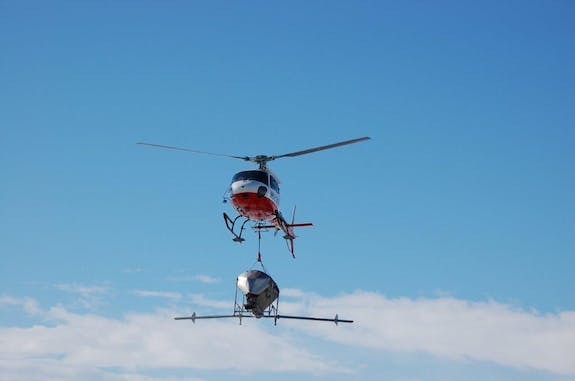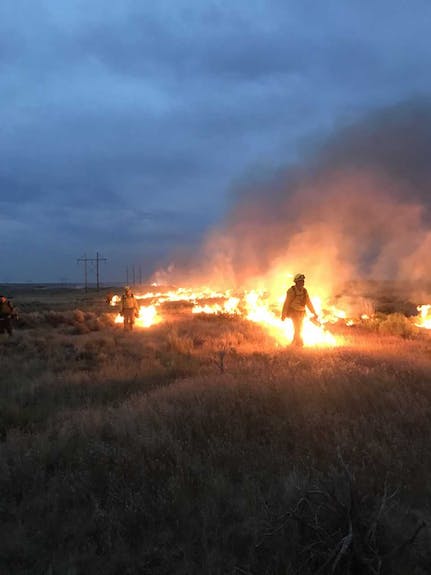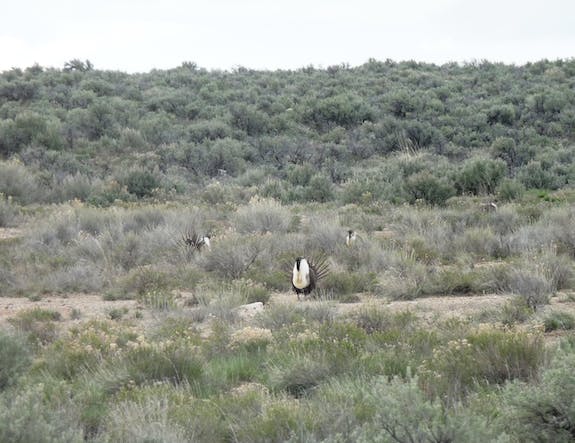As summer nears and Idaho National Laboratory prepares for fire season, the Sheep Fire of 2019 is still fresh in everyone’s collective memory.

Reported on the afternoon of July 22, the lightning-caused fire took four days to bring under control. By July 26, it had burned an estimated 112,106 acres of vegetation, the largest fire in the Site’s 70-year history. The fire affected 21 soils types, nine vegetation classes, and numerous wildlife species, including greater sage grouse, designated as a Species of Greatest Conservation Need by the state of Idaho.
While such an event can never be called a “gift,” the Sheep Fire has brought into focus how the U.S. Department of Energy (DOE) and its Idaho contractors can more effectively protect vegetation and animal habitat on the 890-square-mile Site.
“The last 10 years have brought changes in ecological conditions and the regulatory environment,” said Amy Forman of Veolia Nuclear Solutions-Federal Services, the company that manages the INL Environmental Surveillance, Education and Research (ESER) program for DOE’s Idaho Operations Office. While firefighting and habitat preservation have always been a team effort, new agreements have brought more stakeholders to the table and made broader resources available.
Collaborative aerial seeding
Fires are a fact of life on the INL desert Site. “We manage our operation around the fire threat,” said INL Fire Chief Eric Gosswiller. Because of changes in the local ecology, the probability of large fires like last summer’s is on the rise.

Some things about the Sheep Fire made it unique. Despite the fire’s size, damage to INL property was limited to signs, incidental storage at one location and 12 INL power distribution poles. No buildings were affected and there were no reported injuries. Close to 75% of the land burned in the Sheep Fire had already burned at least once before, and some sections had burned four or five times.
As spring 2020 approached, the U.S. Bureau of Land Management (BLM), U.S. Fish and Wildlife Service (USFWS) and Idaho Office of Species Conservation helped DOE aerially seed 25,000 acres of burned sagebrush habitat. This was possible because of a 2014 agreement that DOE signed with USFWS, mandating proactive protection of sage grouse habitat.
Two areas within the footprint of the Sheep Fire were proposed for aerial sagebrush seeding. The highest priority area was 12,521 acres within the Sage Grouse Conservation Area (SGCA). The second 11,828-acre area was adjacent to the SGCA. Both areas were identified as having a good potential for providing seasonal habitat to sage grouse and other species that need sagebrush to survive.

DOE, the Idaho Office of Species Conservation and the USFWS bought about 8,000 pounds of bulk sagebrush seed from the BLM seed warehouse. BLM also provided an additional 1,600 pounds of seed at no cost through an excess property transfer.
“We have a lot more agency stakeholders at the table, and these agencies have in-depth experience,” said Betsy Holmes, a physical scientist with DOE. “We’ve had a lot of fantastic input, knowledge and insight from these stakeholder agencies.”
That level of cooperation is also reflected on the Wildland Fire Management Committee, which dates back to 2003. In the Sheep Fire’s aftermath, the committee took “a very purposeful look” at what needs to be done, Gosswiller said.
Specifically, it developed a post-fire recovery plan to address impacts of fire suppression activities and potential effects of the fire on native species recovery and associated wildlife habitat. The document includes a five-year monitoring plan to identify areas of greatest risk for poor recovery and to assess the success of post-fire treatments.
A new complication: cheatgrass
The time between 2012’s Midway Fire and the Sheep Fire gave the ESER program’s environmental scientists and wildlife biologists a valuable window. They used it to make detailed vegetation maps of the area for DOE. These up-to-date, accurate maps helped as Veolia’s scientists assess the burn area. The maps have aided in the plans for habitat restoration.

Approximately 80% of the area burned by the Sheep Fire was dominated by native species and was characterized as fair to good ecological condition before the fire occurred. The remaining 20% of the burned area was dominated by cheatgrass or other nonnative species, a sign of poor condition.
“Cheatgrass is a growing concern,” Veolia’s Forman said. Common in western Idaho, it has only recently started becoming abundant at the INL site. Once it starts to increase, it spreads fast. Cheatgrass is a winter annual whose seeds germinate in the fall. By spring, its seedlings are rooted while most native vegetation is only getting started. This makes it capable of outcompeting native species for water and nutrients. It only takes a few plants to produce enough seeds to overwhelm native perennials.
Also, cheatgrass dries out by mid-June, making fires more likely to occur earlier in the season. Mid-summer fires are tough on native flowering plants and grasses, but less so on cheatgrass. Because its seeds drop prior to fires and germinate with fall precipitation, the cycle gives rise to dense, continuous stands that make additional fire ignition and spread more likely.
In some parts of the West, fire return intervals have gone from 60 to 110 years in sagebrush-dominated systems to less than five years under cheatgrass dominance. With every reoccurring fire, cheatgrass becomes more dominant and expands its range.
Before the Jefferson Fire of 2010, cheatgrass was documented to be widely distributed across the INL Site, but at low densities that weren’t considered a threat to post-fire recovery of sagebrush habitat. As it became more widespread and abundant, however, it has become an important consideration in post-fire vegetation management.
Vegetation in about 20% of the area affected by the Sheep Fire was dominated by nonnatives. In some places, areas treated to control cheatgrass may have enough perennial native vegetation to recover sufficiently. Other areas, where the abundance of native species is particularly low, may require reseeding with native perennial species to improve the ecological condition.
Lines of containment

Fire containment lines constructed with bulldozers were necessary for firefighters to safely and effectively contain the Sheep Fire. Reseeding of those lines began in May, after precautions were taken to preserve cultural resources. The highest priority areas were then recontoured and planted with a native grass mix. Planting during the recontouring process eliminates the need for additional visits to the containment lines and limits traffic to land that has already been disturbed. Minimizing the disturbance also helps revegetation because it limits soil compaction and the risk of accidentally introducing nonnative species.
Resprouting native species has an advantage in dry years. Precipitation in the Pacific Northwest and Northern Rockies from February through April was reported much below average by the National Oceanic and Atmospheric Administration’s National Centers for Environmental Information. Higher than average temperatures in late May and early June promised more drying across the Snake River Plain desert.
Regardless of what happens, firefighting efforts and habitat management go hand in hand, Gosswiller said. “INL is vulnerable to large fires every season,” he said. “We’re going to do the same seasonal planning we always have, including prioritizing post-fire recovery activities.”
The Sheep Fire of 2019 demonstrated that the growing number of agency stakeholders involved has benefited not only the habitat but fire containment efforts. “Our agency partners have been absolutely essential,” said Holmes.





